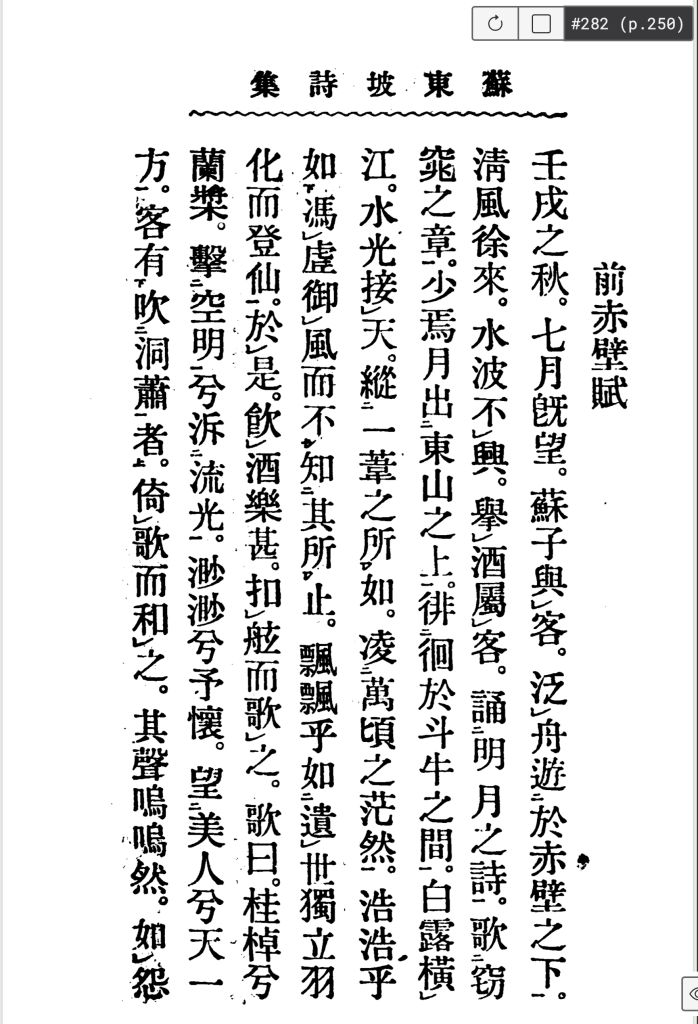My collection: http://: https://babel.hathitrust.org/cgi/mb?a=listis&c=1122358922
This collection is based on works written by Tao, Qian and Su, Shi. They were both very famous authors one thousand years ago and their works are wide spread in East Asia. The screenshots shows the Chinese version and the Japanese version of Su, Shi’s Qian Chibi Fu. Even though they look very similar, how they sound are very different. Take the first sentense for example, the Chinese version is pronounced as “Ren xu zhi qiu” while the Japanese version is “jin jyutsu no aki.” They sound completely different from each other. It is interesting to see how Chinese and Japanese have similar writing system but very different speaking system one thousand years ago.
As you can see in the screenshots below, this book has Chinese on one page and Japanese on another page and their writing systems share so many similarities. I am able to establish a connection to The Baitál pachísí in the lightning talk mindmap. It is very similar to the books written in multiple languages during the colonial era. In addition, the Xin yue ji (The crescent moon) also connects to the example below since both are collections of poems. Both are written in non-simplified Chinese in a vertical order from right to left. However, as you read the actual content of them, you can find that their use of grammar and choice of words are completely different while the hanzi characters they use are the same. Xin yue ji is more colloquial and informal and my example is more serious and hard to understand.
Catalog: https://catalog.hathitrust.org/Record/102432966
Click on the screenshot to see the Hathitrust page.


Japanese (starting from the second right most column)

From Xiaoxi Zhang’s presentation on a Chinese translation of Bengali prose poems via English, I learnt that Chinese has two different sets of characters and writing systems. To me, it is mind-blowing to see that written Chinese is completely different from today, and I am unable to read if I time traveled to China 100 years ago. Also, Zhang’s presentation is one of my major reasons to research deep into ancient Chinese literature in Asian297. During my research, I found a fun fact that at that time, translated books about math, science, and engineering were written from left to right horizontally at that time, since the translators found it annoying and hard to read if they tried to squeeze all the math formulas in the Chinese texts written horizontally.
In Kimberly’s blog, I really like how she compared two versions of Jing Ping Mei published in different times to show how the way of language is being used and the examples of the transformation of Chinese characters. Even though both literature and characters evolved a lot during centuries, from her example, I learned the change in the language itself. And the later part is a perfect example of how Chinese change in its form of writing, making connection to my discussion about the ancient writing system in China and Japan, as well as my connection to Xin Yue Ji.
Jing Ping Mei and Chinese Character Transformation
Highlighting translation
I managed to get access to the no-full-view book via the interlibrary loan, which is super cool. The book is a Chinese-English translation of the poems and the author made connection between Tao, Qian, the poet, and a British poet, David Watson since Tao, Qian work satifies Watson’s theory of poetry. This is a connection that can never be found by robots.
Category: translation
Under this category, I am able to connect my work with abschmit, tsween, huang, zhang and yan’s discussion on their collections
Link to network: http://www.translationnetworks.com/networks/341



You must be logged in to post a comment.